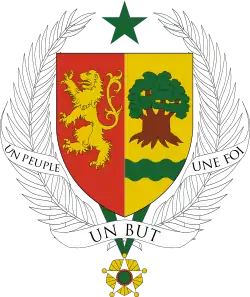| War Jaabi | |||||
|---|---|---|---|---|---|
| Manna Dynasty | |||||
| Reign | ?? – 1041 | ||||
| Predecessor | Rabis | ||||
| Successor | Labi | ||||
| Died | 1041 | ||||
| Issue | Labi | ||||
| |||||
| Father | Rabis | ||||
| Religion | Islam | ||||
War-Dyabe (Arabic: وار ذياب بن ربيس) or War Jabi[1] (Arabic: وار جابي), also known as: War Jaabi or War-Dyabe, was the first Muslim king of Tekrur in the 1030s, the first to proclaim Islam as a state religion in the Sudan.
Background
War Jabi was a member of the Manna dynasty that had ruled Takrur since the early 800s. His father Rabis may be the Rai bin Rai mentioned in Arabic sources as an ally of the Almoravids and king of the Sudan.[2]: 65 Islam had been brought to Takrur by Soninke merchants and spread widely.[2]: 64
Reign
War Jabi converted to Islam and forced his subjects to convert to Islam, introducing sharia law in the Kingdom in 1035.[1] This greatly benefited the state economically and created greater political ties with the Muslim states of North Africa that would be important in the later conflicts with the animist state of Ghana.[3]
He died in 433 Hijri (1040 or 1041 Gregorian), and was succeeded by his son Labi.[4]
Serer Exodus
War Jabi's enforcement of sharia law pushed the Serer people of Tekrur (land owners and "the local agricultural people"[5]), who refused Islam in favour of their traditional religion, out of the country.[1][6] That resulted in their migration to Baol and Sine.[1]
Legacy
The name "War" means "death" in the Serer language. The old Serer anti-Islamic and anti-Arab term "the spurns of War" and "the spurns of Leb" are in reference to him and his son. They are pejorative terms.
See also
Sources
- Barry, Boubacar. Senegambia and the Atlantic slave trade, (Cambridge: University Press, 1998) p. 6
- Clark, Andrew F. and Lucie Colvin Phillips. Historical Dictionary of Senegal: Second Edition, (Metuchen, New Jersey: Scrarecrow Press, 1994) pp. 18; 265
- Fage, J. D.; Oliver, Roland Anthony, "The Cambridge History of Africa: From c. 500 B.C. to A.D. 1050", Cambridge University Press (1975), p. 485, ISBN 9780521209816 - last retrieved 20 June 2022
- Cohen, Robert Z., Discovering the Empire of Ghana, The Rosen Publishing Group, Inc. (2013), p. 39, ISBN 9781477718889 - last retrieved 20 June 2022
- Levtzion, Nehemia (1973). Ancient Ghana and Mali. New York: Methuen & Co Ltd. p. 44,183. ISBN 0841904316.
Notes
- 1 2 3 4 Colvin, Lucie Gallistel, Historical dictionary of Senegal, Scare Crow Press Inc. (1981), p. 18, ISBN 0-8108-1369-6
- 1 2 Kane, Oumar (2004). La première hégémonie peule. Le Fuuta Tooro de Koli Teηella à Almaami Abdul. Paris: Karthala. Retrieved 12 July 2023.
- ↑ Robinson, David (12 January 2004). Muslim Societies in African History. Cambridge: Cambridge University Press. ISBN 978-0-521-53366-9. Retrieved 14 October 2015.
- ↑ Levtzion, Nehemia (1973). Ancient Ghana and Mali. New York: Methuen & Co Ltd. p. 44,183. ISBN 0841904316.
- ↑ Fage, J. D.; Oliver, Roland Anthony, "The Cambridge History of Africa: From c. 500 B.C. to A.D. 1050", Cambridge University Press (1975), p. 485, ISBN 9780521209816 - last retrieved 20 June 2022
- ↑ Cohen, Robert Z., Discovering the Empire of Ghana, The Rosen Publishing Group, Inc. (2013), p. 39, ISBN 9781477718889 - last retrieved 20 June 2022

